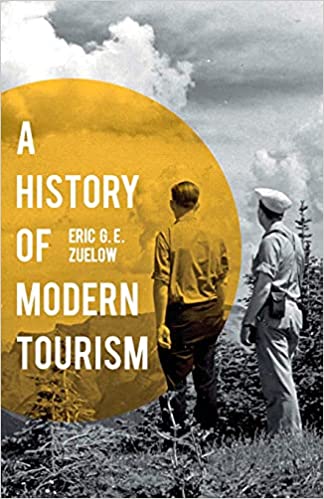When I traveled to India as a young man, I was without a doubt a tourist. I pored over Lonely Planet travel guides and used them to plan my itinerary, which included musts such as the Taj Mahal and the Palace of Winds in Jaisalmer. I bought a plane ticket and carried travelers checks and a camera in my rucksack, staying at hotels and eating at cafes where I could meet and hang out with other tourists.
In beginning to write about this experience, which was formative in my life, I began to ask myself why I picked India of all places — what alchemy of cultural signals delivered to my brain this singular thought. But an ancillary question also arose, which is how this entire mode of travel came to be. How did we all learn to venerate beaches and mountains rather than grain fields and power plants? What was the origin of the infrastructure we’ve come to expect — the hotel room with bathroom en suite, the buses, the guidebooks?
Eric G. E. Zuelow has done his best to figure it all out. Though Zuelow starts with a few stabs at ancient tourism — he has a tendency to start chapters with panoramas so sweeping as to become ridiculous — the larger arc is one that all feels pretty familiar if you know your European history, although Zuelow does a fine job of putting it all together in the right context. We begin with the 18th-century Grand Tour for gentlemen, see how Romantic ideas of the sublime alter what’s considered worth seeing and doing, and watch as technology and social change expand tourism down the social ladder. Inventions like steam ships, steam trains, automobiles, and planes are obvious means of widening tourism’s scope, but Zuelow is good at connecting these inventions (and others less obvious, like the bicycle) to social changes such as changing beach culture, working class summer camps, and much more.
This is a hinky book, with many gaps that the author acknowledges, which is the result of a first foray into an understudied field. (One might say that Zuelow has gone off the beaten track, to borrow a tired phrase from the tourism industry.) It’s also full of fascinating stories like the rise of Thomas Cook from a promoter of Scottish tours to a worldwide travel manger or the complicated process of turning train travel from a terror to a luxury. As we get into the period after World War II, we get to see the creation of the sort of family car trip that was, by 1983, so mockable in National Lampoon’s Vacation, and then the shift from that kind of trip to more individual, personal journeys of the sort valorized in Eat Pray Love.
Through it all, Zuelow reminds us just how important tourism is, both economically and culturally. It has now spread from the West to the world, and it’s something nearly everyone aspires to, and nearly everyone who can engages in. We live for our vacations. Considering the huge place tourism has in our lives and societies, it’s a wonder there aren’t more studies like this. One hopes there will be.

